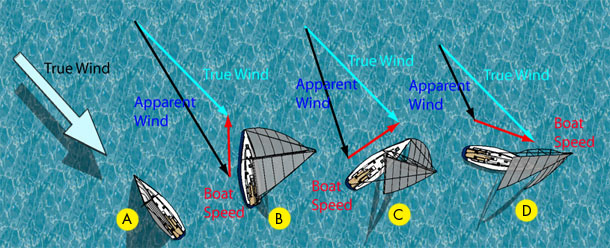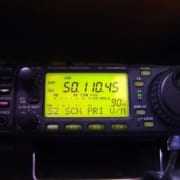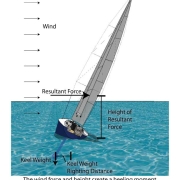Understanding true vs apparent wind
Here is an easy description of true wind and apparent wind. Put you hand outside the window of your car traveling at 60 miles per hour on a still day and your hand will feel a 60 mile per hour wind. That’s apparent wind yet the true wind is zero. What if the car was driving into a 20 mile per hour head wind? Your hand would feel 80 mph. Or if the wind was blowing from behind at 20 mph, your hand would feel 40mph.
Now what about a cross wind of 20 miles per hour? Well we need to do a little Pythagorean theorem work on this. What is the square root of the sum of 60 squared plus 20 squared? Your hand would feel 63.24 mph and mostly from a direction in front of the car. If the car accelerated to 100 mph your hand would feel 102 mph again mostly from the front. If the car decelerates to 10 mph your hand would feel 22 mph mostly from the side of the car and if he car stopped you’d feel the full true wind of 20 miles per hour from the side of the car. What ever your hand feels is the apparent wind. The apparent wind equals the true wind when your car is not moving.
When determining direction of the wind, the faster the car goes the more the apparent wind direction comes from the direction of travel of the car. Again imagine the cross wind. At 1 mph the apparent wind feels almost like the true wind from across the car. As the car accelerates the wind feels more and more like it is coming from the front.
This is similar to a boat. The faster the boat sails into the wind, the more the apparent wind speed increases and the more it feels like it is coming from the front of the boat. As a general rule of thumb then, when sailing the true wind is about 15 degrees more towards the back of the boat. IE point to where you feel the wind is coming from then point 15 degrees further back and that is about where the true wind is coming from.
The following diagram illustrates this.
If you liked this article, please Share it or Digg it below. It helps spread the word of NauticEd.
- RYA Day Skipper with NauticEd - April 1, 2024
- NauticEd uses the SailTies GPS Tracking App - March 29, 2024
- Sea of Cortez Flotilla – February 2025 - March 8, 2024









The sentence “As a general rule of thumb,….” describes the direction of true wind in exactly the opposite way of your illustration. The illustration shows that true winds is generally 15 degrees ahead of apparent wind. Which one is correct, the illustration or the text?
Good question, one that had me thinking for a second. Actually, the text and the illustration are both right. the text actually says the true wind is 15 degrees more towards the rear of the boat.
It’s a matter of the addition of the vectors. If you look at the actual angles, the true wind is coming from behind more than the apparent wind. I’ll answer it in the next blog rather than here so that I can add an illustration to explain better. But essentially if you are sailing along and point to the wind that you feel (apparent wind) then point about 15 degrees more towards the rear of the boat – you’ll get the approximate true wind. Again – this is a general rule and Pythagoras takes precedent here.